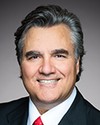Good morning, Madam Chair and members of the committee. Thank you for the opportunity to appear before you to comment on the national trade corridors fund.
The Western Transportation Advisory Council, WESTAC, is a tripartite council of major organizations represented by business executives, labour leaders and government decision-makers. Founded in 1973, WESTAC has a history as a credible, balanced forum. We facilitate collaborative actions to improve western Canada's freight transportation system.
Our membership is a unique group of competing parties including ports, railways, terminals, major importers and exporters and labour unions, as well as the western provincial and territorial governments and Transport Canada.
Today's presentation is based on information from and discussion with the council's industry members.
First of all, we thank the government for establishing a national trade corridors fund. It was a critical initiative to reduce bottlenecks, improve the flow of goods movement and support trade diversification.
In particular, many members, especially in B.C., have been successful in obtaining NTCF funding for projects that reduce trade impacts on local communities, increase system resiliency and benefit exporters across the west.
As Peter said, projects would not be proceeding without this federal support. Transport Canada staff have been excellent at advancing applications in a timely manner without sacrificing appropriate diligence.
We believe that the NTCF was a good first step to addressing key trade infrastructure projects; however, looking longer term, a larger, more strategic program for trade-enabling infrastructure will be needed to capture growth.
Now I will turn to three points we believe are important in the conversation around trade corridors: capacity, reputation and leadership. This information is directly from our annual compass transportation leader survey and dialogue among our members.
Capacity within the transportation and trade network continues to be the prevailing concern both currently and looking ahead 30 years. Addressing congestion that is challenging capacity in key rail corridors and in the last mile before port facilities is essential.
Recent analysis shows that marine terminal capacity on the west coast in Prince Rupert and Vancouver is sufficient across all commodities except oil until 2023, but challenges come in the middle to late 2020s. Rail capacity is currently challenged in some corridors. Railways are investing to reduce constraints. About 20% of the revenue goes into capital improvements. Approximately $5.5 billion will be invested in 2019.
Canada has slipped in global competitiveness rankings for logistics, according to the World Bank logistics performance index. Members report that trading partners are concerned that Canada is not a reliable supplier. WESTAC's survey supports this, with a third of industry leaders stating our reputation has worsened.
Capacity constraints and reputational declines are symptoms of the large problem of the need for coordination and leadership across this industry. We are optimistic that the time to act is now. Leaders from all areas of transportation are signalling a shift in thinking and awareness that, to make next-level improvements in our trade corridors, we have to move beyond silos. Canada needs an explicit supply chain plan.
As one executive said:
All the players involved in transportation need to get on the same page, now. It's critical there is a meeting of the minds between regulators, shippers, carriers, logistics hubs and ports on improving the efficiency of the system overall.
As this committee knows, a national trade corridors strategy, or at the very least a western Canadian strategy, is essential. We fully support the dialogue and fact-finding necessary to create one.
A strategy can provide a leadership framework by articulating priorities for the national supply chain network. This can narrow and align priorities amongst the overwhelming menu of investment choices and stakeholders. This supports the objective of an integrated and interdependent network amongst highways, railways, airports and marine ports. In its absence, we are left with an inventory of individual projects, all of which may have merit, but without a basis upon which to recommend coherent infrastructure priorities and their relative value to trade.
The theory is not only to address the infrastructure gaps, but also to stay one step ahead of emerging challenges and opportunities.
Finally, I leave you with these thoughts.
Transportation corridors need sustained increased funding. Trade-enabling infrastructure offers government some of the highest ROI in economic terms of any category of infrastructure. Trade and transportation infrastructure provides economic returns that pay for all the other infrastructure, for example, social, green and urban transit.
We need formal arrangements for long-term collaboration and leadership in western Canada's trade corridors, and action must be taken quickly. The competitiveness gap between Canada and other nations is steadily widening at the cost of this country's long-held reputation for great performance and reliability. Other countries are pushing hard to grab greater market share.
In the wise words of one survey respondent, “If we don't act together now, as leaders, we will lose what momentum we have. Our reputation will continue to decline and capacity will remain constrained.”
Thank you.









